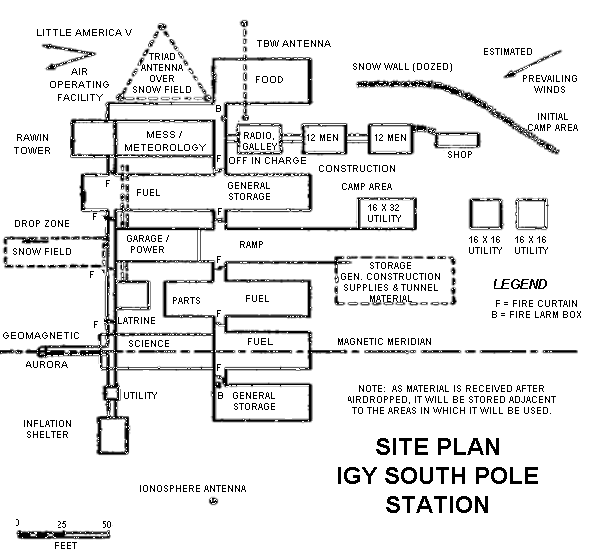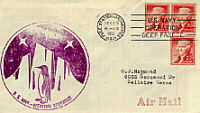






|

|

|

|

|
 | ||||


|
SOUTH POLE, 9 JAN 97 The old South Pole Station, now defunct, lays buried by 30 feet of ice and snow. It is currently being crushed from the top, bottom and sides by enormous pressure being exerted from the Polar Plateau. Long since abandoned (circa 1976) by the U.S. Navy, the Old South Pole Station, or First South Pole Station, was dug into the ice in 1956-57. The U.S. Navy operated out of there until 1975 when the new South Pole Station was brought on line by the U.S. Navy Seabees. The new station was then given over to the civilians to operate and the U.S. Navy's presence at the South Pole was decreased to only a handful of personnel who remained to operate the Ground Control Approach Tower that guides the Navy's ski-equipped LC-130 Hercules aircraft into the South Pole. These planes supply our station with everything from food, to fuel and personnel. (NOTE: To maintain a significant American presence in the Antarctic, the U.S. Government has an exclusive contract with the Lockheed Corporation, maker of the LC-130. The contract stipulates that Lockheed shall only build ski-equipped LC-130's for the U.S. military's use in the Antarctic; sales of this type of aircraft to foreign nations for use in the Arctic and Antarctic is strictly prohibited).
When the U.S. Navy dumped and ran from the Old Pole they left everything behind, unacceptable by today's standards. Since the beginning of Antarctic exploration all bases of operation have been left to Mother Nature to deal with, which she does well. Roald Amundsen was the first to abandon his bases. [Ed. note: This is not quite true as the first to winter-over on the continent was Carsten Borchgrevink, leader of the Southern Cross Expedition in 1898-1900. One of Borchgrevink's huts still stands intact at Cape Adare]. Tradition was carried on by Admiral Byrd. All five of his Little America camps have now since broken off the Ross Ice Shelf as icebergs and melted into the great southern ocean. Scott's and Shackleton's leftover garbage is now treated as ancient relics to be coveted. Today's Antarctic garbage is still only garbage though. In the years following the Old South Pole Station closure, the winter-over crew at the new station always take a trip over and down into the buried station as a certain "bonus" to those wintering through the long season. This "trip" is totally unauthorized by any of the management personnel. One of the surest ways to get a quick plane ride out of here is to take an unauthorized trip over to Old Pole during the summer! The entire site is off limits to everyone due to the fact that it is collapsing. To make matters worse, no records are available pertaining to the location of anything such as vent shafts, doors, trapdoors, garbage pits, sewer outfalls, etc. On one of these trips and / or maybe one of the authorized recons into the Old Pole, it was noticed that there was leftover JP8 diesel fuel still in the 10,000 gallon fuel bladders. Not much in each, but enough between them all to make a substantial amount. It was estimated to be around 10,000 gallons total, a total I was to refute until several days later when approximately that much was finally pulled out. All of those little bits sure didn't seem like they would add up that high, but they did. Congratulations to those who did the calculations. With the diesel being that old, we weren't sure that we wanted to try and burn the fuel in any of our equipment. The contamination probability was simply too large. We would find ourselves repairing equipment if it turned out to be bad stuff. But, we do have a group here called PICO (Polar Ice Coreing Office) from the University of Nebraska that are currently doing the ice core drilling for the National Science Foundations efforts and programs. They use burner units that can accommodate this type of fuel oil. PICO uses about 10,000 gallons of diesel fuel a week for their hot water drilling operations anyway, so if they could use this fuel a multitude of dollars would be saved since fuel would not need to be flown in. This would basically be free fuel from the U.S. Navy if we could find a way to get it out. Fuel is brought to the U.S. Antarctic Base, McMurdo Station, by an oil ship once a year. It is then loaded into the fuel tanks of the LC-130's that supply the South Pole Station. Once it reaches the South Pole it is then off-loaded from the wings of the planes into our fuel bladders. If the plane gives us the maximum amount of fuel allowable, less what is necessary for a safe ride back, then that is almost 3000 gallons. Thus, over 3 flights per week of drilling must be dedicated just to the PICO drilling operations. This summer they hope to drill seven cores into the Polar Plateau using almost 80,000 gallons of diesel. Pretty expensive fuel. So the fuel retrieval is looking better all the time. The only expense would be our labor of getting the fuel back out, which is much cheaper than flying in another 10,000 gallons. So, the trip begins. Surface link to Old South Pole Station Topside entrance into Old South Pole Station Top of the staircase, just below the snow slide  I did not find the post office at this time, however I did manage to find it later that morning. I only found some postal bulletins dated from the early and mid-seventies. They did a good job of removing the governments official documents and devices. As a matter of fact, that was probably the only place that anything was removed. The first fuel arch we came across did not have any fuel left in the fuel bladders. I experienced a strange and different feeling from beneath my boots as we moved through the fuel arch. I looked down, shining the light at the ice around my feet. It had a purple and white glow to it and was all the wrong consistency. After a minute I recognized it as being what we call PKP. PKP is what is used in most of the dry chemical fire extinguishers. It's a purple powder that goes everywhere when charged by the nitrogen propellant. I didn't see any remnants of a fire, so maybe some of the extinguishers had simply burst. No problem, it was the wrong arch anyway. Off we went in search of another arch which, to my delight, resulted in more exploration around the station. We looked for different materials along the way, materials we thought might still be useable, in an attempt to remove some of this stuff out of the station. We found thousands of plumbing parts and board feet of timber. We found parts for heaters and boilers as well as thousands of weather balloons. (We managed to get the balloons). The further we marched in the worse off the station became. The floor is lifting, by five feet in places, with the structural columns shattering in the middle as the weight from above and the upheaval from below is ever increasing. The arches are made from steel, each piece being about 2 feet wide and 25 feet tall. These are hooked together over a 200-foot run. Even these are buckling under the pressure. The bulkheads at the ends are falling in. In some places the ceiling lights are only 4 feet from the floor. Some of the corridors off of the main area going back to the science, meteorology and areas that we have no idea what they were for, are barely passable anymore. Some of my explorations took me through areas that had to be accessed on my knees. It won't be long before many of the areas are completely gone. Potentials for a severe accident due to the forces of nature are great, which is probably the primary reason for keeping the public out.
The Old South Pole Station was designed to be buried by snow in some places while clear from it in others. But certainly not to the extent it is now. In the beginning a large, long trench was dug out and the base built inside the trench. Large columns, most of them made of 6 X 6 wood beams, were stood upright every few feet. Outer containment walls were then added to the sides to hold back the snow and ice. A roof was then brought in to complete the outer structure. Different arches and tunnels were then dug and joined together to complete the rest of the station. Emergency exit hatches and vent towers were added as necessary as the snow built up on top of the station. Little modular buildings were built between and around the support columns. A large kitchen and dining room were added almost at the front entrance. A radio room, library and sleeping quarters were set aside by rank and time of enlistment. Latrine modules were set up and sewer outfalls poked into the walls of ice. Count your blessings now for modern toilets and conveniences! The younger enlisted men's latrine was hardly anything more than 5-6 outhouses tied together. The other enlisted men and officer's latrine were quite plush in comparison. Rank certainly has its privileges, especially in the military. Shops were set up for the plumbers, electricians, the meteorology team, science technicians, photographers, mechanics, administration personnel, etc. The Boardwalk Scott at the staircase leading out of Old South Pole Station
[Next] The Explorers Home Page Antarctic Philately [Contents] Antarctic Philatelic Website Contents |